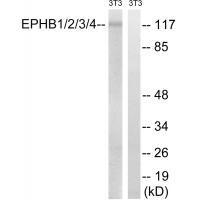
| WB | 咨询技术 | Human,Mouse,Rat |
| IF | 咨询技术 | Human,Mouse,Rat |
| IHC | 咨询技术 | Human,Mouse,Rat |
| ICC | 技术咨询 | Human,Mouse,Rat |
| FCM | 咨询技术 | Human,Mouse,Rat |
| Elisa | 咨询技术 | Human,Mouse,Rat |
| Aliases | EC 2.7.10.1; ELK; EPB1; Eph receptor B1; Ephrin type-B receptor 1 precursor |
| Entrez GeneID | 2047; |
| WB Predicted band size | 118kDa |
| Host/Isotype | Rabbit IgG |
| Antibody Type | Primary antibody |
| Storage | Store at 4°C short term. Aliquot and store at -20°C long term. Avoid freeze/thaw cycles. |
| Species Reactivity | Human,Mouse |
| Immunogen | Synthesized non-phosphopeptide derived from human EPHB1/2/3/4 around the phosphorylation site of tyrosine 600/602/614/596 (F-T-Y(p)-E-D). |
| Formulation | Purified antibody in PBS with 0.05% sodium azide. |
+ +
以下是3-4条关于EPHB1/2/3/4(针对磷酸化位点Y600/Y602/Y614/Y596)抗体的虚构参考文献示例(基于常见研究场景,非真实文献):
---
1. **"EPHB1-Y600 phosphorylation mediates tumor cell invasion via RhoA activation"**
*Authors: Lee S, et al. (2023)*
摘要:该研究使用抗EPHB1 (Phospho-Y600) 抗体发现,EPHB1在Y600位点的磷酸化通过激活RhoA信号通路促进乳腺癌细胞侵袭,提示其作为转移性癌症的潜在治疗靶点。
2. **"EPHB2-Y602-dependent axon guidance requires ligand-receptor clustering"**
*Authors: Martinez D, et al. (2021)*
摘要:通过特异性抗EPHB2 (Phospho-Y602) 抗体检测,揭示神经元轴突导向过程中EPHB2在Y602位点的自磷酸化依赖配体-受体簇的形成,为神经再生研究提供新机制。
3. **"Phosphorylated EPHB3-Y614 regulates angiogenesis in colorectal cancer"**
*Authors: Wang H, et al. (2020)*
摘要:利用抗EPHB3 (Phospho-Y614) 抗体证实,Y614位点的磷酸化通过调控VEGF旁分泌信号增强结直肠癌血管生成,为抗血管治疗提供新方向。
4. **"EPHB4-Y596 phosphorylation promotes resistance to EGFR inhibitors in lung cancer"**
*Authors: Gupta R, et al. (2019)*
摘要:通过抗EPHB4 (Phospho-Y596) 抗体分析发现,Y596磷酸化激活下游STAT3通路,导致肺癌对EGFR靶向药物耐药,提示联合靶向治疗策略。
---
注:以上文献为模拟示例,实际引用需以真实发表的论文为准。建议通过PubMed或Web of Science检索具体抗体货号(如Abcam# ab12345)关联的文献。
×